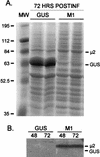The reovirus protein mu2, encoded by the M1 gene, is an RNA-binding protein
- PMID: 9733883
- PMCID: PMC110211
- DOI: 10.1128/JVI.72.10.8354-8357.1998
The reovirus protein mu2, encoded by the M1 gene, is an RNA-binding protein
Abstract
The reovirus M1, L1, and L2 genes encode proteins found at each vertex of the viral core and are likely to form a structural unit involved in RNA synthesis. Genetic analyses have implicated the M1 gene in viral RNA synthesis and core nucleoside triphosphatase activity, but there have been no direct biochemical studies of mu2 function. Here, we expressed mu2 in vitro and assessed its RNA-binding activity. The expressed mu2 binds both poly(I-C)- and poly(U)-Sepharose, and binding activity is greater in Mn2+ than in Mg2+. Heterologous RNA competes for mu2 binding to reovirus RNA transcripts as effectively as homologous reovirus RNA does, providing no evidence for sequence-specific RNA binding by mu2. Protein mu2 is now the sixth reovirus protein demonstrated to have RNA-binding activity.
Figures




Similar articles
-
Silencing and complementation of reovirus core protein mu2: functional correlations with mu2-microtubule association and differences between virus- and plasmid-derived mu2.Virology. 2007 Aug 1;364(2):301-16. doi: 10.1016/j.virol.2007.03.037. Epub 2007 Apr 23. Virology. 2007. PMID: 17451769 Free PMC article.
-
Comparisons of the M1 genome segments and encoded mu2 proteins of different reovirus isolates.Virol J. 2004 Sep 23;1:6. doi: 10.1186/1743-422X-1-6. Virol J. 2004. PMID: 15507160 Free PMC article.
-
Reovirus mu2 protein determines strain-specific differences in the rate of viral inclusion formation in L929 cells.Virology. 2000 Jun 20;272(1):16-26. doi: 10.1006/viro.2000.0362. Virology. 2000. PMID: 10873745
-
The reovirus μ2 protein, an enigmatic multifunctional protein with numerous secrets yet to be uncovered.Virology. 2025 Jan;601:110275. doi: 10.1016/j.virol.2024.110275. Epub 2024 Oct 24. Virology. 2025. PMID: 39515007 Review.
-
The structure and function of the reovirus genome.Ann N Y Acad Sci. 1980;354:107-24. doi: 10.1111/j.1749-6632.1980.tb27961.x. Ann N Y Acad Sci. 1980. PMID: 7013618 Review. No abstract available.
Cited by
-
Silencing and complementation of reovirus core protein mu2: functional correlations with mu2-microtubule association and differences between virus- and plasmid-derived mu2.Virology. 2007 Aug 1;364(2):301-16. doi: 10.1016/j.virol.2007.03.037. Epub 2007 Apr 23. Virology. 2007. PMID: 17451769 Free PMC article.
-
Guanidine hydrochloride inhibits mammalian orthoreovirus growth by reversibly blocking the synthesis of double-stranded RNA.J Virol. 2007 May;81(9):4572-84. doi: 10.1128/JVI.02106-06. Epub 2007 Feb 14. J Virol. 2007. PMID: 17301147 Free PMC article.
-
A Cytoplasmic RNA Virus Alters the Function of the Cell Splicing Protein SRSF2.J Virol. 2017 Mar 13;91(7):e02488-16. doi: 10.1128/JVI.02488-16. Print 2017 Apr 1. J Virol. 2017. PMID: 28077658 Free PMC article.
-
The reovirus μ2 C-terminal loop inversely regulates NTPase and transcription functions versus binding to factory-forming μNS and promotes replication in tumorigenic cells.J Virol. 2021 Apr 26;95(10):e02006-20. doi: 10.1128/JVI.02006-20. Epub 2021 Mar 3. J Virol. 2021. PMID: 33658345 Free PMC article.
-
Reovirus μ2 Protein Impairs Translation to Reduce U5 snRNP Protein Levels.Int J Mol Sci. 2022 Dec 31;24(1):727. doi: 10.3390/ijms24010727. Int J Mol Sci. 2022. PMID: 36614170 Free PMC article.
References
-
- Brantley J D, Hunt A G. The N-terminal protein of the polyprotein encoded by potyvirus tobacco vein mottling virus is an RNA-binding protein. J Gen Virol. 1993;74:1157–1162. - PubMed
-
- Burd C G, Dreyfuss G. Conserved structures and diversity of functions of RNA-binding proteins. Science. 1994;265:615–621. - PubMed
-
- Calnan B J, Tidor B, Biancalana S, Hudson D, Frankel A D. Arginine-mediated RNA recognition: the arginine fork. Science. 1991;252:1167–1171. - PubMed
Publication types
MeSH terms
Substances
Grants and funding
LinkOut - more resources
Full Text Sources

